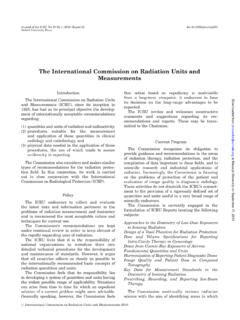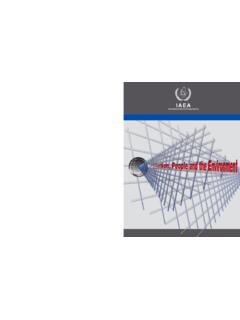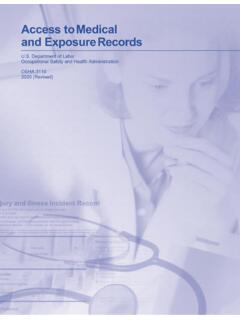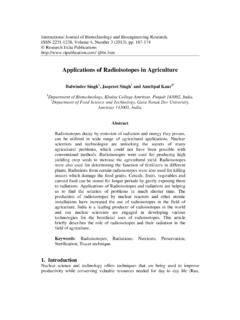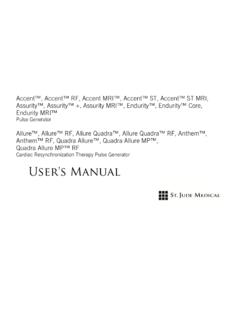Transcription of Chapter 2: Radiation protection concepts and principles
1 COMMUNICATING Radiation RISKS IN PAEDIATRIC IMAGING InformatIon to support healthcare dIscussIons about benefIt and rIsk / 29 COMMUNICATING Radiation RISKS IN PAEDIATRIC IMAGING InformatIon to support healthcare dIscussIons about benefIt and rIsk / 29 Chapter 2: Radiation protection concepts and principlesNew health technologies and medical devices using ionizing Radiation have led to major improvements in the diagnosis and treatment of human disease. However, inappropriate or unskilled use of such technologies and devices can lead to unnecessary or unintended exposures and potential health hazards to patients and staff.
2 When establishing a risk benefit dialogue about paediatric imaging it is important to communicate that risks can be controlled and that benefits can be maximized by selecting an appropriate procedure and using methods to reduce patient exposure without reducing clinical effectiveness. Section presents concepts and principles of Radiation protection and discusses how they are applied to paediatric imaging. Section summarizes the key factors to establish and maintain a Radiation safety culture in health care to improve / COMMUNICATING Radiation RISKS IN PAEDIATRIC IMAGING InformatIon to support healthcare dIscussIons about benefIt and rIsk30 / COMMUNICATING Radiation RISKS IN PAEDIATRIC IMAGING InformatIon to support healthcare dIscussIons about benefIt and Appropriate use of Radiation in paediatric imaging Fundamentals of Radiation protection in health care medical imaging referrers and providers The International Basic Safety Standards for protection against Ionizing Radiation and for the Safety of
3 Radiation Sources (BSS) establish specific responsibilities for health profes-sionals related to Radiation protection and safety in medical exposures (BSS, 2014). The BSS define a health professional as an individual who has been formally recognized through appropriate national procedures to practice a profession related to health ( medicine 1, dentistry, chiropractic, podiatry, nursing, medical physics, medical Radiation technology, 2 radiopharmacy, occupational health) .The BSS defines a radiological medical practitioner (RMP) as a health professional with specialist education and training in the medical uses of Radiation , responsible for adminis-tering a Radiation dose to a patient and competent to perform independently or to oversee procedures involving medical exposure in a given specialty (BSS, 2014).
4 The radiological medical practitioner has the primary responsibility for Radiation protection and safety of patients. While some countries have formal mechanisms for accreditation, certification or registration of RMPs, other countries have yet to adequately assess education, training and competence on the basis of either international or national standards. In the context of this document, the term RMP will be used to generically refer to the large group of health professionals that may perform radiological medical procedures ( as defined in the BSS) and more specific terms will be used when/as appropriate ( radiolo-gist 3 ).
5 The concept of a RMP primarily includes classical medical specialties using ion-izing Radiation in health care: diagnostic radiology, interventional radiology (image-guided procedures), Radiation oncology and nuclear medicine. However, in some cases, specializa-tion of a RMP may be narrower, as with dentists, chiropractors, or podiatrists. Likewise, for diagnostic imaging and/or image-guided procedures, cardiologists, urologists, gastroenter-ologists, orthopaedic surgeons or neurologists may use radiology in a very specialized way. Moreover, clinicians in some countries perform and/or interpret conventional imaging such as chest X-rays.
6 1. Including physicians as well as physicians assistants2. This includes radiographers and other radiological technologists working in diagnostic radiology, interventional radiology and nuclear medicine3. In the context of this document, the term radiologist is used in a generic way to include diagnostic and/or interventional radiology. In some countries diagnostic radiology and interventional radiology are established as different disciplines, each of them with specific residency and board certification2. Radiation protection concepts and principlesCOMMUNICATING Radiation RISKS IN PAEDIATRIC IMAGING InformatIon to support healthcare dIscussIons about benefIt and rIsk / 31 COMMUNICATING Radiation RISKS IN PAEDIATRIC IMAGING InformatIon to support healthcare dIscussIons about benefIt and rIsk / 31In the context of this document a referrer is a health professional who initiates the process of referring patients to a RMP for medical imaging.
7 For paediatric imaging in particular, the health professionals who most often refer patients for diagnostic imaging are paediatricians, family physicians/general practitioners. Emergency department physicians, paediatric sub-specialists, physicians assistants and other paediatric health-care providers also often refer children for paediatric imaging within their daily practice. Ultimately, any medical specialist may need to refer paediatric patients for medical imaging and, under those circumstances, would be considered a referrer . Usually, the referrer and the RMP are different people. However, both roles are sometimes played by the same person often deemed self-referral.
8 For example, dentists decide whether an X-ray exam is indicated, they interpret the images and, in many countries, they also perform the procedure. medical imaging staff of a radiology department typically comprise a multidisciplinary team which include radiologists, radiographers/radiological technologists, medical physicists and The principles of Radiation protection in medicineAlthough individual risk associated with Radiation exposure from medical imaging is generally low and the benefit substantial, the large number of individuals being exposed has become a public health issue. Justification and optimization are the two fundamental principles of Radiation protection in medical exposures, 4 as follows:1.
9 medical exposures shall be justified by weighing the expected diagnostic or therapeutic benefits against the potential Radiation detriment, with account taken of the benefits and the risks of available alternative techniques that do not involve exposure to radia-tion. The procedure should be judged to do more good than harm. 2. The principle of justification applies at three levels in medicine (ICRP, 2007a) as de-scribed below: At the first level, the proper use of Radiation in medicine is accepted as doing more good than harm to society; At the second level, a specified procedure is justified for a group of patients showing relevant symptoms, or for a group of individuals at risk for a clinical condition that can be detected and treated.
10 And At the third level, the application of a specified procedure to an individual patient is justified if that particular application is judged to do more good than harm to the individual The justification of a particular radiologic medical procedure is generally endorsed by national health authorities and professional societies ( to recommend a procedure for those at risk of a particular condition). 54. The responsibility of justifying a procedure for a patient 6 falls upon individual profes-sionals directly involved in the health-care delivery process (referrers, RMPs). Imaging 4. Although the Radiation protection system is based on three principles : justification, optimization and dose limi-tation, in the case of medical exposures dose limits are not applied because they may reduce the effectiveness of the patient s diagnosis or treatment, thereby doing more harm than good (ICRP, 2007a)5.










